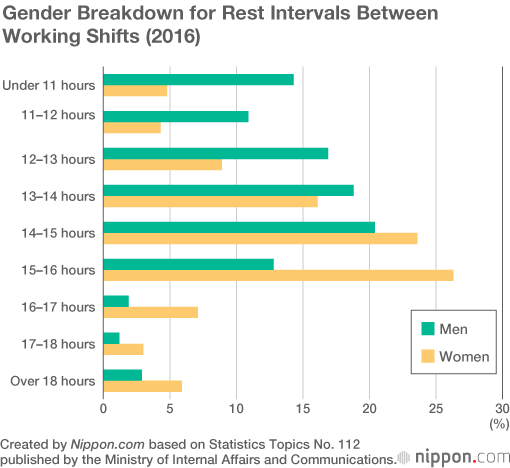
Over 10% of Japanese Workers Get Less than 11 Hours Rest and Recuperation Between Shifts
Society- English
- 日本語
- 简体字
- 繁體字
- Français
- Español
- العربية
- Русский
A rest interval of 11 hours for sleep and recuperation between working shifts is considered the minimum required for maintaining one’s health. Some 10.4% of Japanese workers fail to enjoy this minimum amount, however, according to statistics from a 2016 survey by the Ministry of Internal Affairs and Communications. This is a 0.4% increase compared to the same survey conducted five years ago. Although there are differences depending on job type, there has been no major improvement in the overall situation of long working hours in Japan.
Percentages for Different Rest Intervals Between Working Shifts (2016)
| 2011 (%) | 2016 (%) | |
|---|---|---|
| Under 11 hours | 10.0 | 10.4 |
| 11–12 hours | 8.3 | 8.2 |
| 12–13 hours | 12.4 | 13.6 |
| 13–14 hours | 16.8 | 17.7 |
| 14–15 hours | 23.9 | 21.7 |
| 15–16 hours | 19.2 | 18.3 |
| 16–17 hours | 4.1 | 4.0 |
| 17–18 hours | 1.9 | 1.9 |
| Over 18 hours | 3.5 | 4.1 |
Created by Nippon.com based on Statistics Topics No. 112 published by the Ministry of Internal Affairs and Communications.
The statistics focus on full-time white-collar workers with fixed working hours and do not include part-time workers and irregular workers at production plants and the like. The interval between shifts is defined as the period of time from the end of work one day to the beginning the next, so if a worker’s job ends at 6 pm and then starts up again at 9 am the following day, the interval would be 15 hours.
The “work-style reform” legislation approved by the Diet in June 2018 clearly states that companies should strive to introduce a system to ensure appropriate intervals between each working shift. The survey found that the most common length for intervals is between 14 and 15 hours, which was the length for 21.7% of the workers surveyed (2.2% lower than in 2011), followed by 18.3% for between 15 and 16 hours (0.9% lower), and 17.7% for between 13 and 14 hours (0.9% higher).
There was a wide gender gap among those whose rest intervals were shorter than 11 hours in 2016, at 14.3% for men (0.7% higher than in 2011) and 4.8% for women (0.2% higher). Men, on the whole, had shorter intervals between working shifts than women. The age bracket with the shortest intervals were those aged 25 to 29, among whom 13.7% had intervals of less than 11 hours, a sharp increase over the 7.8% in 2011.

By job, teachers were most likely to have rest intervals shorter than 11 hours, with 26.3% of them falling under this category in 2016, followed by technicians at 15.1%, salespersons at 14.0%, healthcare and medical workers at 8.0%, and retailers at 6.8%. From these statistics it is particularly striking that rest intervals for one in four teachers fall short of 11 hours.
(Translated from Japanese. Banner photo © Pixta.)